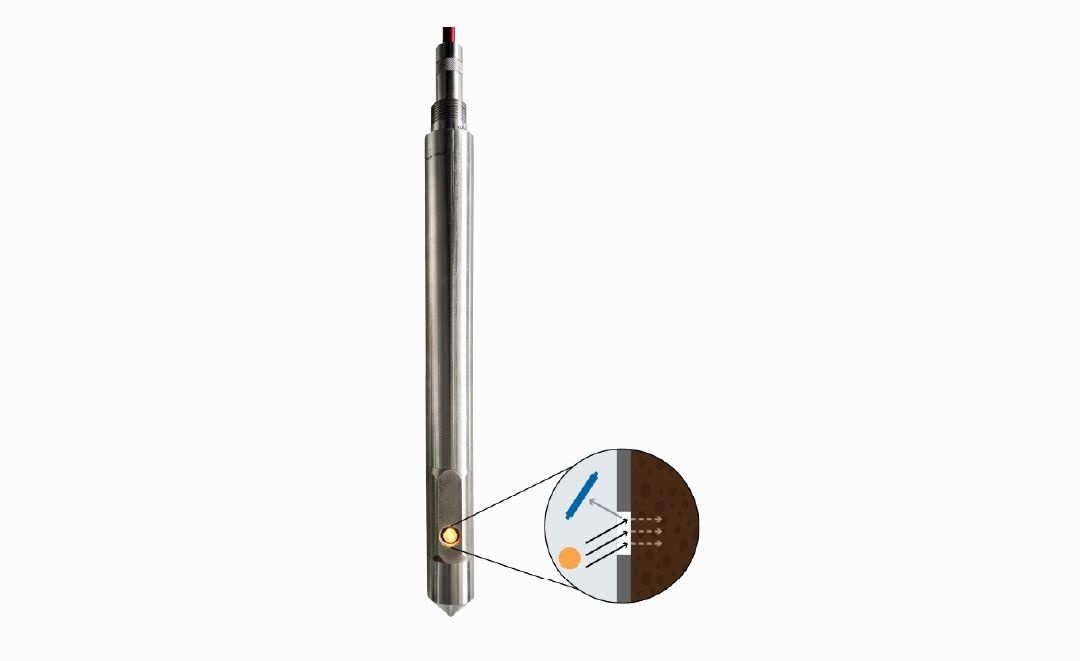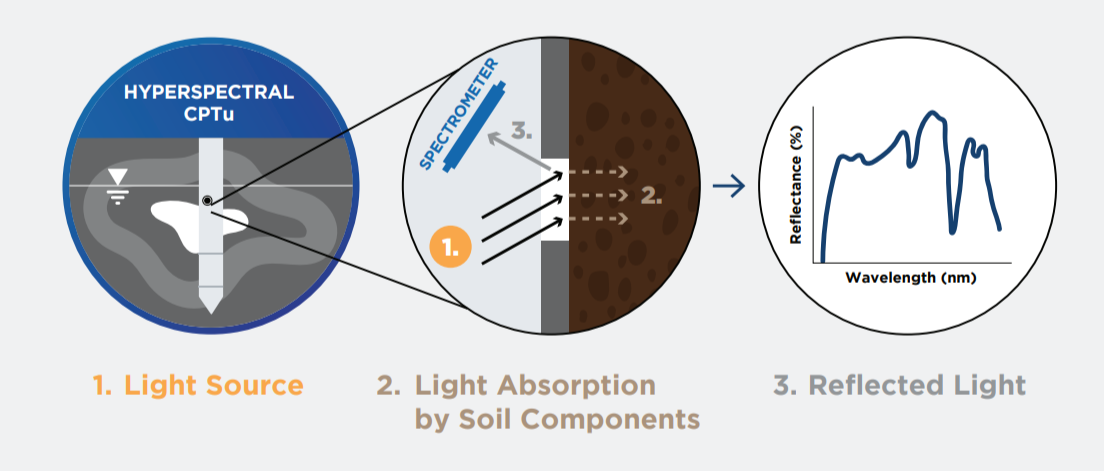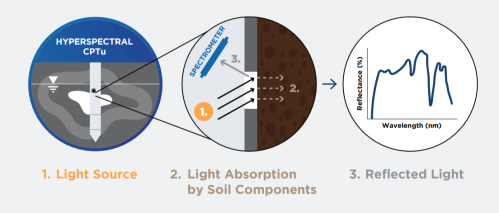Hyperspectral Cone Penetration Testing (hyperspectral-cptu™)

HYPERSPECTRAL CONE PENETRATION TESTING
Hyperspectral-CPTu™ (Patent-Pending)
In geotechnical and geoenvironmental site investigations, characterization of the properties of soils and soil-like materials is crucial. This often requires a combination of in-situ testing and sampling methods. Traditionally, laboratory testing and Cone Penetration Testing (CPTu) have been the go-to techniques for soil characterization. While laboratory testing offers a comprehensive analysis of various soil properties, from geotechnical to chemical aspects, it involves drilling, sampling, and subsequent transportation, which escalate costs and introduce logistical hurdles. Moreover, the time-consuming nature of laboratory work and variability in results underscore the necessity for improved techniques. In-situ Hyperspectral-CPTu offers a promising solution to address the aforementioned challenges, reducing cost, time, and environmental impacts associated with sampling and laboratory testing.
The patent pending Hyperspectral Cone Penetration Test (Hyperspectral-CPTu™) is an in-situ soil characterization method that combines traditional CPTu with real-time hyperspectral reflectance sensing to rapidly assess soil properties like moisture, mineralogy, and particle size.

HYPERSPECTRAL SENSING AND ITS POTENTIAL
Hyperspectral sensing, a technique widely employed in various industries such as agriculture, environmental science, mining, and food processing, provides valuable insights into material properties. By measuring reflected light across different wavelengths, spectral sensors can discern information about chemical composition and physical characteristics of materials.
This versatile method serves dual purposes, enabling both qualitative and quantitative assessments of various materials and substances. In soil science, this method is particularly useful for:
- Identification and quantification of minerals
- Estimation of water content
- Identification and estimation of contaminants
- Quantification of particle size parameters

Unlocking Soil Insights with Hyperspectral-CPTu
ConeTec is pioneering the integration of hyperspectral sensing into the CPTu. This patent-pending innovation allows for real-time, continuous hyperspectral reflectance data collection during CPTu or SCPTu operations. The synergistic integration of hyperspectral data with CPTu data (or SCPTu), powered by machine learning algorithms unlocks a wealth of new insights into soil properties such as fines content, water content, and mineralogy.
By generating more comprehensive stratigraphic data at a faster pace and with reduced drilling and lab analysis requirements, this integrated methodology transforms soil characterization practices, leading enhanced site investigations and informed decision-making in geotechnical and geo-environmental contexts.

QUANTITATIVE ESTIMATIONs
Hyperspectral sensing facilitates quantitative assessments of soil properties by correlating spectral signatures with specific parameters of interest. Through empirical relationships established between hyperspectral features and target properties, we may derive quantitative estimations with high accuracy. For example, the absorption features of water molecules in the near-infrared region vary with soil moisture content, enabling the development of predictive models for moisture estimation (e.g. Entezari et al. 2016; Bindner et al. 2025). Similarly, the intensity of hyperspectral bands corresponding to mineral compositions can be used to quantify mineralogical constituents within the soil (e.g. Entezari et al. 2017; Debaene et al. 2023). ConeTec has successfully used hyperspectral sensing for quantitative estimation of oil sands tailings properties (Entezari et al. 2022).
By calibrating hyperspectral data against reference measurements obtained from laboratory analyses, robust quantitative models can be constructed for diverse soil properties, including mineral content, organic carbon content, and contamination levels.
QUALITATIVE ESTIMATIONs
In qualitative analysis, reflectance spectroscopy helps identify and characterize different components present in the soil. By analyzing the spectral signature (the unique pattern of light absorption and reflection across various wavelengths) we may be able discern the presence of minerals, organic matter, and contaminants. Each component exhibits distinct spectral features, allowing for their identification without the need for physical extraction or laboratory testing. For instance, the spectral signature of contaminants such as hydrocarbons or heavy metals provides clues about their presence and distribution within the soil matrix.
Example Hyperspectral Data
PROPOSED TEST PROGRAm
To advance the development and validation of Hyperspectral-CPTu technology, ConeTec proposes a collaborative test program designed to pair in-situ data collection with laboratory analysis:
- Conduct Hyperspectral-CPTu/SCPTu (module added and data collected during planned CPTu operations).
- Collect sonic core over the CPTu locations, or disturbed samples from other means adjacent to the Hyperspectral-CPTu/SCPTu sounding for laboratory analysis of constituents of interest, such as plastic fines, moisture content, particle size distribution (PSD), and index testing. Lab results would need to be shared with ConeTec for research purposes.
- Perform bench-top hyperspectral data collection from the samples to complement the Hyperspectral-CPTu data and for cross-calibration purposes.
- ConeTec Research will utilize the paired lab and in-situ data to develop models to estimate constituents of interest from Hyperspectral-CPTu data at no cost to the client.
- Results can enhance future programs by enabling estimation of key parameters (e.g., moisture content, fines content) directly from Hyperspectral-CPTu data.
CLOSING
ConeTec proposes the adoption of Hyperspectral-CPTu at client sites to advance spectroscopy in soil science and geotechnical assessment. By collaborating with clients, ConeTec aims to build spectral libraries of soils and develop models for estimating various soil properties. This innovative approach promises to enhance the efficiency and accuracy of geotechnical assessments while propelling the broader application of spectroscopy in soil science.
For more information contact us at www.conetec.com/contact
references:
Bindner, J., Bareither, C., & Scalia, J. IV. (2025). Ex situ hyperspectral sensing and machine learning for tailings characterization. Canadian Geotechnical Journal, 62, 1–15.
Debaene, G., Bartmiński, P., & Siłuch, M. (2023). In situ VIS-NIR spectroscopy for a basic and rapid soil investigation. Sensors, 23(12), 5495.
Entezari, I., Rivard, B., Lipsett, M. G., & Wilson, G. W. (2016). Prediction of water content and normalized evaporation from oil sands soft tailings surface using hyperspectral observations. Canadian Geotechnical Journal, 53, 1742–1750.
Entezari, I., Rivard, B., Geramian, M., & Lipsett, M. G. (2017). Predicting the abundance of clays and quartz in oil sands using hyperspectral measurements. International Journal of Applied Earth Observation and Geoinformation, 59, 1–8.
Entezari, I., McGowan, D., & Glavina, J. (2022). Hyperspectral imaging (HSI) technology for oil sands tailings characterization: practical aspects. Proceedings of Tailings and Mine Waste 2022, Denver, Colorado, US.














QUICK LINKS